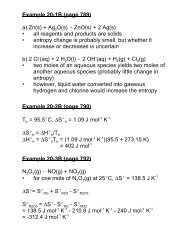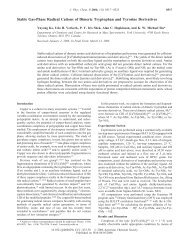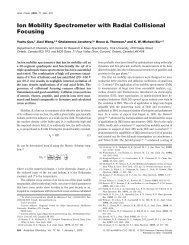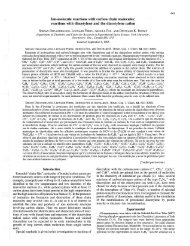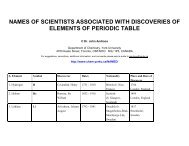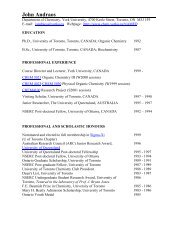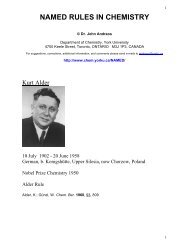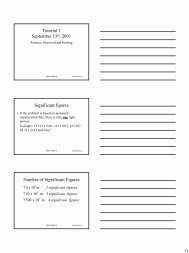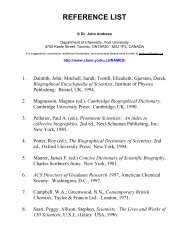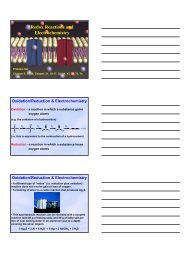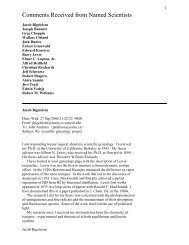Acids and Bases
Acids and Bases
Acids and Bases
You also want an ePaper? Increase the reach of your titles
YUMPU automatically turns print PDFs into web optimized ePapers that Google loves.
Chapter 18 - Additional Aspects of Acid-Base Equilibria• should be familiar with problems like those done inPractice Examples 18-3 <strong>and</strong> 18-4 (calculations similarto those in Practice Examples 18-7 <strong>and</strong> 18-8 areincluded in the lecture notes)Example 18-2A (page 714)Calculate [H 3 O + ] <strong>and</strong> [CHO 2 - ] in a solution that is 0.100 MHCHO 2 <strong>and</strong> 0.150 M NaCHO 2 .- this is a buffer of formic acid <strong>and</strong> sodium formateHCHO 2 W CHO 2-+ H +Initial 0.100 M 0.150 M 0Change -x +x +xEquilibrium 0.100 - x 0.150 + x xK a = [CHO 2 - ][H + ]/[HCHO 2 ] = 1.8 x 10 -4{(0.150 + x)(x)}/(0.100 - x) = 1.8 x 10 -4- assume x
Example 18-5 (page 719)What mass of sodium acetate must be dissolved in 300.0 mLof 0.25 M acetic acid to produce a solution with a pH of 5.09?(Assume that the solution volume remains constant at300.0 mL.)CH 3 COOH(aq) W CH 3 COO - (aq) + H + (aq) K a = 1.8 X 10 -5pH = 5.09 = -log[H + ]log[H + ] = -5.09[H + ] = 10 -5.09 = 8.128 X 10 -6 M- the amount of H + is small <strong>and</strong> therefore the concentration ofacetic acid at equilibrium will be essentially the same as theinitial concentrationK a = [CH 3 COO - ][H + ]/[CH 3 COOH] = 1.8 X 10 -5[CH 3 COO - ](8.128 X 10 -6 )/(0.25) = 1.8 X 10 -5[CH 3 COO - ] = 0.554 Mmass of sodium acetate required= (moles of sodium acetate)X(MW of sodium acetate)= {[CH 3 COO - ](volume of solution)}X(MW of sodium acetate)= {(0.554 M)(0.300 L)}X(82.034 g mol -1 )= 14 g
Example 18-6A (page 723)A 1.00 L volume of a buffer is made with concentrations of0.350 sodium formate <strong>and</strong> 0.550 M formic acid.HCHO 2 W CHO 2 - + H + K a = [CHO 2 - ][H + ]/[HCHO 2 ] = 1.8 x 10 -4a) What is the initial pH?- since this is a buffer we can assume that the concentrationsof formic acid <strong>and</strong> the formate ion at equilibrium areessentially the same as the initial concentrations[H + ] = K a X [HCHO 2 ]/[CHO 2 - ][H + ] = 1.8 x 10 -4 X (0.550)/(0.350) = 2.839 x 10 -4 MpH = -log [H + ] = -log(2.839 x 10 -4 ) = 3.55b) What is the pH after the addition of 0.0050 moles of HCl?(Assume that the volume remains constant at 1.00 L.)• this is equivalent to adding 0.0050 M HCl to the buffer• adding a strong acid will increase the amount of theconjugate acid (e.g. formic acid) <strong>and</strong> decrease theamount of the conjugate base (e.g. formate ion)CHO 2 - + H + 6 HCHO 2[HCHO 2 ] = 0.550 M + 0.0050 M = 0.555 M[CHO 2 - ] = 0.350 M - 0.0050 M = 0.345 M[H + ] = K a X [HCHO 2 ]/[CHO 2 - ][H + ] = 1.8 x 10 -4 X (0.555)/(0.345) = 2.896 x 10 -4 MpH = -log [H + ] = -log(2.896 x 10 -4 ) = 3.54Note: slightly more acidic
c) What would be the pH after the addition of 0.0050 mol ofNaOH to the original buffer?• this is equivalent to adding 0.0050 M NaOH to the buffer• adding a strong base will increase the amount of theconjugate base (e.g. formate ion) <strong>and</strong> decrease theamount of the conjugate acid (e.g. formic acid)HCHO 2 + OH - 6 CHO 2 - + H 2 O[CHO 2 - ] = 0.350 M + 0.0050 M = 0.355 M[HCHO 2 ] = 0.550 M - 0.0050 M = 0.545 M[H + ] = K a X [HCHO 2 ]/[CHO 2 - ][H + ] = 1.8 x 10 -4 X (0.545)/(0.355) = 2.763 x 10 -4 MpH = -log [H + ] = -log(2.763 x 10 -4 ) = 3.56Note: slightly more basic




